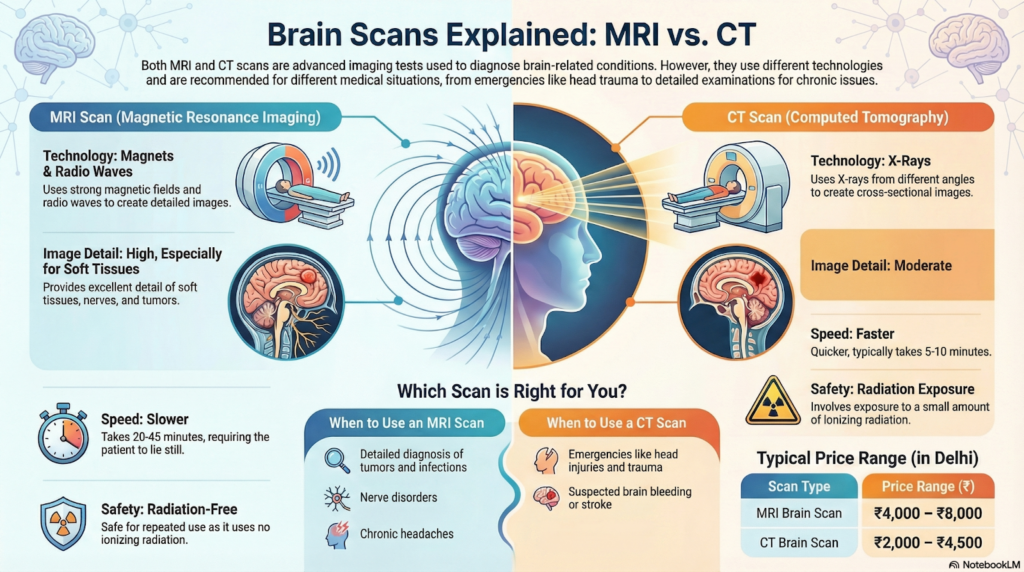MRI vs. CT Scan: Which Is Best for Your Brain?
When it comes to diagnosing brain-related problems, doctors usually recommend either an MRI scan or a CT scan. Both are advanced imaging tests, but they serve different purposes and are used in different medical situations.
If you are looking for the best brain scan, or comparing MRI vs. CT scan for brain, this guide will help you understand which test is right for you, how much it costs, and when each is recommended.
What Is an MRI Brain Scan?
An MRI Brain Scan (Magnetic Resonance Imaging) is an advanced imaging test that uses strong magnetic fields and radio waves to produce high-resolution images of the brain.
MRI is especially useful for examining:
- Brain tissues
- Nerves
- Blood vessels
- Subtle abnormalities that may not be visible on CT
What Is a CT Brain Scan?
A CT Brain Scan (Computed Tomography) uses X-rays to create cross-sectional images of the brain. It is a fast and widely available test, making it ideal in emergency conditions.
People frequently search online for a CT brain near me when immediate imaging is required after injury or sudden neurological symptoms.
CT scans are commonly used to detect:
- Brain bleeding
- Head injury
- Skull fractures
- Acute stroke
- Swelling in the brain

MRI vs. CT Scan for Brain: Key Differences
| MRI Brain Scan vs CT Brain Scan (Comparison Table) | ||
| Feature | MRI Brain Scan | CT Brain Scan |
| Technology | Magnetic field & radio waves | X-rays |
| Radiation Exposure | ❌ No radiation | ✅ Uses radiation |
| Image Detail | Very high (excellent for soft tissues) | Moderate |
| Scan Time | 20–45 minutes | 5–10 minutes |
| Best Used For | Brain tumors, nerve disorders, epilepsy, infections | Head trauma, brain bleeding, skull fractures |
| Safety | Safer for repeated scans | Limited repeat use due to radiation |
Which Brain Scan Is Better: MRI or CT?
The MRI and CT Scan depends on your symptoms and urgency. Here we are recommended when MRI and CT scan are required according to symptoms and problems.
MRI is required when:
- Detailed brain imaging is needed
- Tumors, infections, or epilepsy are suspected
- Chronic headaches or neurological symptoms are present
- Follow-up scans are required
CT scan is required when:
- There is a head injury or accident
- Brain bleeding is suspected
- A quick diagnosis is needed
- Emergency stroke assessment is required
Also Read: Difference Between MRI and PET CT Scan
MRI Brain Price in Delhi
The MRI brain price in Delhi varies depending on:
- MRI machine type (1.5 Tesla or 3 Tesla)
- Plain or contrast study
- Diagnostic centre location
- Advanced protocols
CT Brain Price in Delhi
The CT brain price in Delhi is generally lower compared to MRI due to shorter scan time and simpler technology.
- Plain or contrast CT
- Emergency or routine scan
- Centre facilities and reporting quality
Is MRI Safer Than CT for the Brain?
Yes. MRI is safer for repeated use because it does not involve radiation.
CT scans, while safe when medically necessary, use X-rays and are generally limited in repeat frequency.
Doctors decide the scan type based on clinical need, not just cost.
Final Words
Both MRI and CT scans play an important role in brain diagnosis. If you need quick imaging, a CT scan may be recommended. But for detailed, accurate, and radiation-free evaluation, MRI is usually the better option.
FAQ
Which is better for brain problems – MRI or CT scan?
For most brain-related conditions like tumors, epilepsy, chronic headaches, infections, or nerve issues, MRI is better because it provides detailed images of soft tissues. CT scans are mainly used in emergencies such as head injury or suspected brain bleeding.
Is MRI safer than CT scan for the brain?
Yes. MRI is safer as it does not use radiation. CT scans use X-rays and are usually avoided for repeated imaging unless medically necessary.
When is a CT brain scan recommended?
A CT brain scan is recommended in emergency situations, such as:
- Head injury or accident
- Suspected brain hemorrhage
- Sudden stroke symptoms
- Severe trauma
What is the MRI brain scan price in Delhi?
The MRI brain price in Delhi generally ranges between ₹4,000 to ₹8,000.
What is the CT brain scan price in Delhi?
The CT brain price in Delhi usually ranges from ₹2,000 to ₹4,500.
How long does an MRI or CT brain scan take?
- CT brain scan: 5–10 minutes
- MRI brain scan: 20–45 minutes
Can MRI detect brain tumors better than CT?
Yes. MRI is far more accurate than CT for detecting brain tumors, small lesions, nerve damage, and infections.
MRI vs. CT Scan: Which Is Best for Your Brain? Read More »
